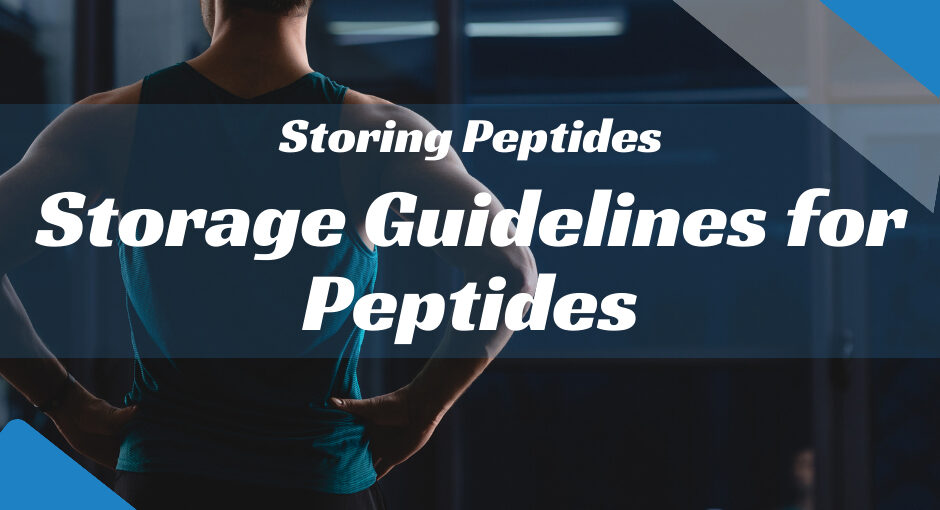Importance of Proper Storage
When it comes to keeping your peptides working, the way you store them affects how long they last and how well they work. Not following storage rules can cause irreversible damage and take away from the benefits that were meant to be gained. Because peptides are sensitive chemicals, they need certain conditions to stay stable and work well. You can make sure that your peptides stay viable and effective for longer by learning and following these storage guidelines. It will help you get the results you want and avoid the potential loss of valuable research materials.
Factors Affecting Peptide Stability
Temperature plays a crucial role in peptide stability. Ideally, storing peptides in a cool, dry place will minimize degradation. The refrigerator is often the best option, with a temperature between 2-8°C, ensuring that they remain in optimal conditions. Additionally, peptides should be kept away from light, moisture, and air exposure, which can lead to hydrolysis and oxidation, diminishing their efficacy. Another important factor is the form in which peptides are stored, whether they are lyophilized (freeze-dried) or in solution. Lyophilized peptides can have a longer shelf life compared to those in solution, thus reinforcing the importance of understanding the specific requirements of the peptide you are working with. By staying informed and conscientious about these factors, you can successfully maintain the integrity of your peptides, leading to enhanced outcomes in your projects.
Temperature Requirements for Peptide Storage
Refrigeration Guidelines
To keep your peptides in great shape, you need to know the right way to store them. Peptides should be kept in the fridge at temperatures between 2°C and 8°C for best results. This range helps to keep the peptides stable and whole while stopping them from breaking down over time. Before putting your peptides in the fridge, make sure they are tightly sealed in the right container to keep them from getting contaminated. You should also clearly name the container, including the type of peptide and the date it was stored. It will help you keep track of how long your peptides will last.
Freezing and Thawing Protocols
If you need to store your peptides for a longer-term period, freezing might be a suitable option. However, it’s essential to follow proper freezing and thawing protocols to avoid damaging the peptides. When freezing, use a freezer that maintains a consistent temperature, preferably around -20°C. When you’re ready to use your peptides, thaw them slowly in a refrigerator or at room temperature. Avoid using hot water or a microwave, as rapid temperature changes can cause denaturation. By applying these temperature storage tips, you can ensure your peptides maintain their effectiveness and provide the best possible results for your projects!
Protection from Light and Moisture
Light-Sensitive Peptides Handling
When it comes to peptide storage, light sensitivity is an important factor you should consider. Many peptides can degrade when exposed to light, compromising their efficacy. To protect your peptides from light, store them in dark, opaque containers. This simple step will shield your peptides from any harmful UV exposure. Additionally, consider keeping them in a designated storage area, away from windows or bright indoor lighting. Always remember to take out only the amount you need and quickly return any unused peptides to their protective storage to minimize their exposure. It will help maintain their quality and effectiveness over time.
Moisture Prevention Techniques
Moisture is another enemy that can significantly affect your peptide’s stability. To prevent moisture damage, it’s best to store your peptides in a dry environment. Using a desiccant packet inside your storage container can effectively keep excess moisture at bay. Additionally, make sure to keep the storage containers tightly closed when not in use to avoid any humidity infiltration. If you are opening containers frequently, it may be beneficial to use a nitrogen-filled container, which can displace moisture from the air. By implementing these moisture prevention techniques, you can ensure your peptides remain stable and effective for your experiments, giving you the best results every time!
Proper Container Selection for Peptide Storage
Types of Containers
Choosing the right container is vital for preserving your peptides. For optimal protection, consider using glass vials or high-quality plastic containers that are specifically designed for peptide storage. Avoid containers that are made from low-grade materials, as they may interact negatively with your peptides. Additionally, select containers that are airtight to prevent air exposure, which can lead to degradation. Look for options that are marketed as chemical-resistant; this ensures that your peptides are safe from any harmful reactions caused by the container itself. If you plan to store larger quantities, opt for bulk containers, but make sure they are still suitable for your specific peptides.
Best Practices for Container Usage
How you handle and use your containers plays a significant role in maintaining peptide integrity. As a scientist, researcher, or laboratory technician, you have a crucial responsibility to ensure your hands are clean and dry before opening containers to avoid contamination. When using a scoop or pipette to extract peptides, opt for sterilized tools, and remember only to take out what you need. Afterward, promptly close the container to limit exposure to light and moisture. If possible, label your containers with essential details, such as the peptide name and date of storage. This practice will help you stay organized and ensure optimal peptide utilization over time. By following these container selection and usage tips, you’ll go a long way in ensuring your peptides remain effective and reliable for all your research needs!
Monitoring Peptide Stability Over Time
Stability Testing Methods
Regular stable testing is not just a recommendation; it’s a necessary step to make sure that your peptides keep working well. To do stable tests, you can look at peptide samples from different times and see if they show any signs of breaking down. High-Performance Liquid Chromatography (HPLC) is one method that can be used to check the purity and quantity of peptides at different times. Mass spectrometry can also help find any changes that have been made to the peptide structure. By conducting these tests regularly, you can be sure that the peptides you’re working with are still useful for your study, providing you with the reassurance you need for your research.
Shelf Life Assessment
Understanding the shelf life of your peptides is crucial to maintaining their integrity. Typically, peptides have a defined shelf life based on the conditions under which they are stored. While some peptides can last for months, others may degrade within weeks. To accurately determine the shelf life, refer to the stability reports provided by the supplier and continuously observe your stored peptides for any physical changes such as color or precipitation. It’s a good practice to create a storage log that keeps track of the storage date and testing results, making it easy for you to monitor the stability over time. By diligently testing and assessing the shelf life of your peptides, you can make informed decisions about their usage, ensuring that your experiments yield reliable and reproducible results.
Transportation and Shipping Considerations
Guidelines for Shipping Peptides
When sending your peptides, adhering to best practices is vital for their stability and effectiveness. Ensure that you use secure packaging materials, such as insulated boxes and cold packs, to help maintain the desired temperature during transit. It’s also wise to label the packages clearly, indicating that they contain sensitive biological materials. This way, carriers can handle them appropriately and reduce the risk of prolonged exposure to unfavorable conditions. Additionally, consider selecting a shipping option that provides tracking services, allowing you to monitor your shipment’s progress and ensure timely delivery.
Temperature Control during Transport
Maintaining proper temperature during the shipping process is crucial for peptide integrity. Peptides are often sensitive to heat and moisture, so they must remain within specified temperature ranges throughout transportation. Gel packs or dry ice, depending on the peptide’s stability requirements, can help keep the temperature in check. Always check with your supplier for specific guidelines on temperature requirements before shipping. Furthermore, avoid shipping during extreme weather conditions, as fluctuations in temperature may compromise the peptides’ quality. By taking these transportation and shipping considerations seriously, you can ensure that your peptides arrive in optimal condition and are ready to be used in your research with confidence.
Summary of Peptide Storage Best Practices
Importance of Adhering to Storage Protocols
Since you work with peptides, you know how important it is to store them properly so that they keep working well. These delicate materials can lose their stability, effectiveness, and usefulness if they are handled incorrectly, which could have a big effect on your study or applications. So, it is very important to follow storage protocols properly. The first thing you should do is put your peptides somewhere cool and dry. The best temperature range is one that your supplier gives you, which is generally between -20°C and -80°C. Frequent changes in temperature are important to avoid because they can cause damage over time. To lower the risks of temperature changes, it is best to store peptides in a freezer that is only used for that purpose.
Last but not least, remember to keep peptides in their original package until you’re ready to use them. A lot of the time, the package protects against light and moisture. When reassembling peptides, make sure you do it in a clean area to avoid getting them contaminated. Taking these suggestions seriously and following standard-keeping methods will not only keep your valuable peptides safe, but they will also make them last longer and work better, which will help you do better work. You will feel better after being aware of this.






